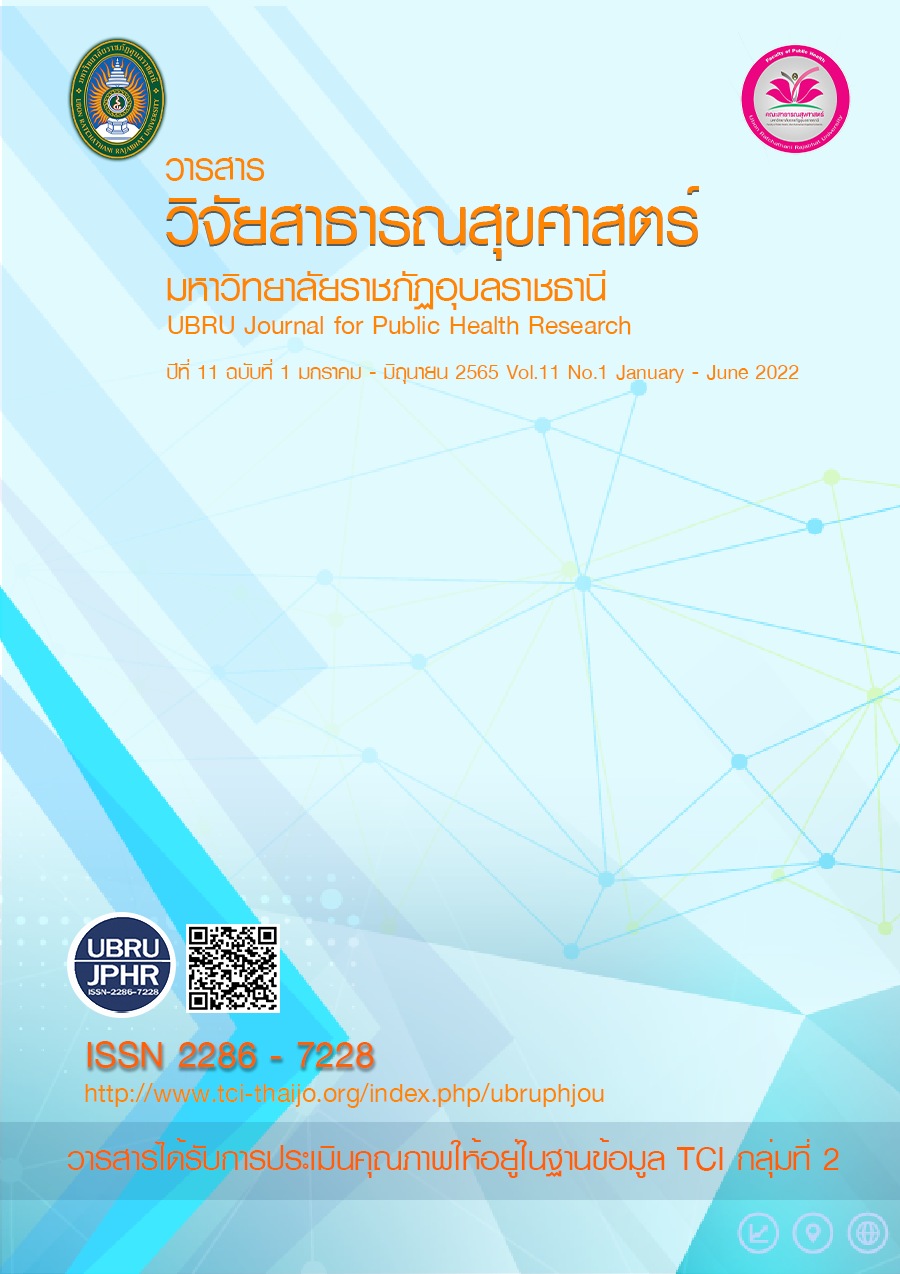Factors associated with risk behavior to be sexual harassed of people in Moo 16, Ban Mae Ka Huay Kean, Maeka district, Phayao Province
Keywords:
Risk behaviors, sexual harassment, peopleAbstract
The purpose of this cross sectional research were to study about the correlation factors about risk behavior to be sexual harassed of people in Moo 16 Ban Mae Ka Huay Kean Maeka district Phayao Province. The sample used in this research was 282 people by accidental sampling. The research instrument used for data collection was questionnaires. Analyzing by description statistics and inferential statistics significantly at the level of 0.05.
The study were found as follow: 71.6 percent of participants was female. 87.9 percent was under 25-year- old, 56.0 percent earned under 5,000 bath a month, 44.0 earned more than 5,001 bath a month, 93.3 percent was single, 93.6 percent was buddhist, 84.0 percent graduated more than bachelor degree, 79.8 percent was students, 61.3 percent drinks alcohol, 67.7 percent went to the club or a bar, 72.0 percent lived in the dorm or condominium. 56.4 percent of the participants knew about the risk behavior to be sexual harassed in high level, 69.5 percent of them have the attitude about the risk behavior to be sexual harassed in moderate level, 75.5 percent access to the policy about the risk behavior to be sexual harassed, 79.1 percent risk to be sexual harassed. The correlation analysis found that sex (p=0.009) status (p=0.080) region (p=0.015) career (p=0.03) drinking behavior (p=0.001) night party behavior (p=0.001) the attitude about sexual harassment (p=0.006) and the policy about preventing to be sexual harassed (p=0.001) effect to the risk behavior to be sexual harassed of the participant significantly at the level of 0.05 besides age, income, education, the dwelling and the knowledge about risk behavior to be sexual harassed do not effect to the behavior.
To summarize, as the research about the risk behavior to be sexual harassed found that the education does not effect to the behavior but the attitude and the policy do. So, people need to get the knowledge and concern about the result from sexual harassment more and should set up the activity about how to protect themselves.
References
เกษร เกตุชู, วิไลพร กาเชียงราย, วิชานีย์ ใจมาลัย และชลลดา ไชยกุลวัฒนา. (2563). “รูปแบบการลดพฤติกรรมการดื่มเครื่องดื่มแอลกอฮอล์ในนักศึกษาระดับปริญญาตรี: การทบทวนวรรณกรรมอย่างเป็นระบบ,” วารสารพยาบาลศาสตร์และสุขภาพ. 43(3): 124-134.
จุฑาทิพย์ พรมวงศ์, อโณทัย งามวิชัยกิจ, และยุทธนา ธรรมเจริญ. (2561).พฤติกรรมการใช้บริการผับและสถานบันเทิงรอบสถานศึกษาของนักศึกษามหาวิทยาลัยในเขตกรุงเทพมหานคร. วารสารบัณทิตศึกษามหาวิทยาลัยราชภัฏวไลยอลงกรณ์ ในพระบรมราชูปถัมภ์. 12(1):23-37.
จอมพลพิทักษ์ สันตโยธิน.(2563). การถูกคุกคามบนอินเทอร์เน็ต : ศึกษาปรียบเทียบมาตการทางกฎหมายในประเทศไทย อังกฤษ และสาธารณรัฐเกาหลี. วารสารกฎหมายและนโยบายสาธารณสุข. 6(2):365-381
ณภัคพงศ์ เฟื่อขุนทด. (2562). การนำนโยบายด้านการป้องกันและแก้ไขปัญหาการล่วงละเมิดหรือคุกคามทางเพศหรือที่ทำงานไปปฏิบัติ : กรณีศึกษากองส่งเสริมความเสมอภาคระหว่างเพศ กรมกิจการสตรีและสถานบันครอบครัว. 1-20.
นวลพรรณ ไม้ทองดี. (2559). การกีดกันเพศหญิงในการจ้างงานวิชาชีพชั้นสูง. วารสารพัฒนาการเศรษฐกิจปริทรรศน์. 10(1): 8-27.
รณภูมิ สามัคคีคารมย์. และอารุญ เกตุสาคร. (2563). ศึกษาเรื่องการสำรวจความคิดเห็นต่อการคุกคามทางเพศบนระบบขนส่งสาธารณะในเขตกรุงเทพมหานคร. วารสารสหศาสตร์. 20(2): 165-185.
โรงพยาบาลจังหวัดพะเยา. (2558). แนวทางปฏิบัติเพื่อป้องกันและแก้ปัญหาการล่วงละเมิดและคุกคามทางเพศในการทำงาน. สำนักงานสาธารณสุขจังหวัดพะเยา.
สราญภัทร อนุมัติราชกิจ. (2563). โครงการอบรมเชิงปฏิบัติการเสริมสร้างพลัง EMPOWERMENT สำหรับนักวิชาชีพ” หรือโครงการ “ผีเสื้อขยับปีก”.
สุฑาทิพย์ คำเที่ยง. (2562). การตกเป็นเหยื่อความรุนแรงทางเพศของเด็กและเยาวชนในสถานศึกษา. วารสารสังคมศาสตร์ คณะรัฐศาสตร์ จุฬาลงกรณ์มหาวิทยาลัย. 5(9): 230-246.
สูติรัตน์ พีรยาวิจิตร. และประยงค์ แสนบุราณ. (2562). การนำหลักธรรมทางพุทธศาสนามาประยุกต์ใช้กับปัญหาการข่มขืนกระทำชำเราในสังคมไทย. วารสานมนุษยศาสตร์วิชาการ. 26(1): 376-399.
สำนักงานปลัดกระทรวงสาธารณสุข. (2563). แนวปฏิบัติเพื่อป้องกันและแก้ไขปัญหาการล่วงละเมิดหรือคุกคามทางเพศในการทำงานของกระทรวงสาธารณสุข. กรุงเทพมหานคร: ศูนย์ปฏิบัติการต่อต้านทุจริต กระทรวงสาธารณสุข. 1(2): 1-85.
หทัยรัตน์ มาประณีต. (2554). การศึกษาทัศนคติด้านความรุนแรงต่อสตรีของสตรีในชุมชนเมือง. วารสารศรีนครินทรวิโรฒวิจัยและพัฒนา(สาขามนุษยศาสตร์ และสังคมศาสตร์). 3(6): 162-177.
อนุช อาภาภิรม. (2543). ฉากความรุนแรงในยุคโลกาภิวัตน์. สถาบันวิถีทรรศน์. สำนักงานการวิจัยแห่งชาติ. (วช.): กรุงเทพฯ.
Cronbach, L. J. Coefficient Alpha and the Internal Structure of Test Psychometrika. 16(1951): 297-334.
Krejcie, R. V. & Morgan, D. W. Determining sample size for researchactivities. Educational and Psychological Measurement. 30, 3(1970): 607-610.
Downloads
Published
How to Cite
Issue
Section
License
Copyright (c) 2022 คณะสาธารณสุขศาสตร์ มหาวิทยาลัยราชภัฏอุบลราชธานี

This work is licensed under a Creative Commons Attribution-NonCommercial-NoDerivatives 4.0 International License.
เนื้อหาและข้อมูลในบทความที่ลงตีพิมพ์ในวารสารวารสารวิจัยสาธารณสุขศาสตร์ มหาวิทยาลัยราชภัฏอุบลราชธานี ถือเป็นข้อคิดเห็นและความรับผิดชอบของผู้เขียนบทความโดยตรงซึ่งกองบรรณาธิการวารสาร ไม่จำเป็นต้องเห็นด้วย หรือร่วมรับผิดชอบใดๆ
บทความ ข้อมูล เนื้อหา รูปภาพ ฯลฯ ที่ได้รับการตีพิมพ์ในวารสารนี้ ถือเป็นลิขสิทธิ์ของวารสารฯ หากบุคคลหรือหน่วยงานใดต้องการนำทั้งหมดหรือส่วนหนึ่งส่วนใดไปเผยแพร่ต่อหรือเพื่อกระทำการใดๆ จะต้องได้รับอนุญาตเป็นลายลักอักษรณ์จากบรรณาธิการวารสารนี้ก่อนเท่านั้น


